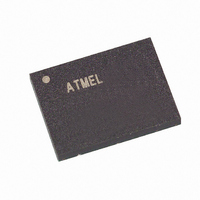AT45DB161B-CNC Atmel, AT45DB161B-CNC Datasheet - Page 8

AT45DB161B-CNC
Manufacturer Part Number
AT45DB161B-CNC
Description
IC FLASH 16MBIT 20MHZ 8CASON
Manufacturer
Atmel
Datasheet
1.AT45DB161B-CC.pdf
(33 pages)
Specifications of AT45DB161B-CNC
Format - Memory
FLASH
Memory Type
DataFLASH
Memory Size
16M (4096 pages x 528 bytes)
Speed
20MHz
Interface
SPI, 3-Wire Serial
Voltage - Supply
2.7 V ~ 3.6 V
Operating Temperature
0°C ~ 70°C
Package / Case
8-CASON
Lead Free Status / RoHS Status
Contains lead / RoHS non-compliant
Other names
AT45DB161-CNC
AT45DB161-CNC
AT45DB161-CNC
Operation Mode
Summary
Pin Descriptions
8
AT45DB161B
If a sector is programmed or reprogrammed sequentially page-by-page, then the pro-
gramming algorithm shown in Figure 1 on page 26 is recommended. Otherwise, if
multiple bytes in a page or several pages are programmed randomly in a sector, then
the programming algorithm shown in Figure 2 on page 27 is recommended. Each page
within a sector must be updated/rewritten at least once within every 10,000 cumulative
page erase/program operations in that sector.
The modes described can be separated into two groups – modes which make use of the
Flash memory array (Group A) and modes which do not make use of the Flash memory
array (Group B).
Group A modes consist of:
1. Main Memory Page Read
2. Main Memory Page to Buffer 1 (or 2) Transfer
3. Main Memory Page to Buffer 1 (or 2) Compare
4. Buffer 1 (or 2) to Main Memory Page Program with Built-in Erase
5. Buffer 1 (or 2) to Main Memory Page Program without Built-in Erase
6. Page Erase
7. Block Erase
8. Main Memory Page Program through Buffer
9. Auto Page Rewrite
Group B modes consist of:
1. Buffer 1 (or 2) Read
2. Buffer 1 (or 2) Write
3. Status Register Read
If a Group A mode is in progress (not fully completed) then another mode in Group A
should not be started. However, during this time in which a Group A mode is in
progress, modes in Group B can be started.
This gives the Serial DataFlash the ability to virtually accommodate a continuous data
stream. While data is being programmed into main memory from buffer 1, data can be
loaded into buffer 2 (or vice versa). See application note AN-4 (“Using Atmel’s Serial
DataFlash”) for more details.
SERIAL INPUT (SI): The SI pin is an input-only pin and is used to shift data into the
device. The SI pin is used for all data input including opcodes and address sequences.
SERIAL OUTPUT (SO): The SO pin is an output-only pin and is used to shift data out
from the device.
SERIAL CLOCK (SCK): The SCK pin is an input-only pin and is used to control the flow
of data to and from the DataFlash. Data is always clocked into the device on the rising
edge of SCK and clocked out of the device on the falling edge of SCK.
CHIP SELECT (CS): The DataFlash is selected when the CS pin is low. When the
device is not selected, data will not be accepted on the SI pin, and the SO pin will
remain in a high-impedance state. A high-to-low transition on the CS pin is required to
start an operation, and a low-to-high transition on the CS pin is required to end an
operation.
2224I–DFLSH–10/04















